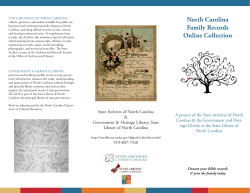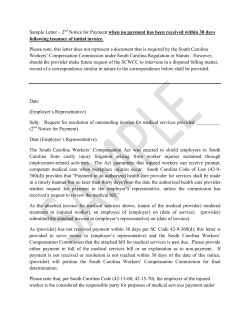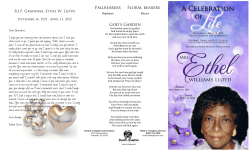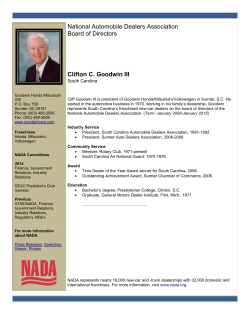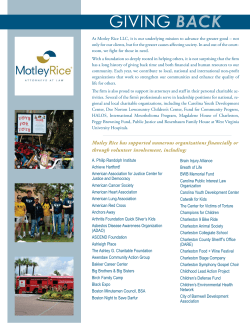
Play and Learn Together A South Carolina Guide to Kindergarten Readiness
Play and Learn Together A South Carolina Guide to Kindergarten Readiness ACKNOWLEDGEMENTS GOALS The Good Start, Grow Smart Task Force is led by the South Carolina Department of Education, Office of Early Childhood. The goals of these standards are: To support the readiness of young children through nurturing early care and education environments and developmentally appropriate practices through the development of voluntary guidelines as required by the Good Start, Grow Smart initiative; To educate and provide guidance for families, educators/ caregivers, administrators, and policymakers on developmental expectations for children in the preschool years; To inform the development of program standards across early learning environments; and To strengthen partnerships between current early childhood efforts — funded by federal, state, local and private funding — to create nurturing early childhood environments to support the school readiness of young children. We would like to acknowledge the hard work and dedication of the following groups who participated in the work of the task force, including the development of the South Carolina Early Learning Standards. South Carolina Department of Education South Carolina Department of Social Services South Carolina Head Start Collaboration Office South Carolina Center for Child Care Career Development Catawba Indian Nation The Sunshine House Child Development Centers Pee Dee Education Foundation South Carolina First Steps to School Readiness We would also like to acknowledge the individuals who helped create this book: Author: Abby Thorman, Ph.D. Graphic Designer: Barbara Hensley This publication was funded by South Carolina Department of Social Services and Department of Education, Office of Early Childhood Education in cooperation with the Good Start Grow Smart Task Force. Play and Learn Together A s a parent or grandparent, you want the best for the child in your life. You want your child to grow up happy, healthy and successful. Sometimes it is hard to know how to best prepare your child for school and life. This booklet is filled with easy, inexpensive ideas you can do at home and on your daily errands. The ideas will help your child get the talking, reading, math, social, personal and creative thinking skills he or she needs to be successful. Some of these ideas may be things you already do. That is great! We hope there are also some new ideas that you can use. Your support, patience, and time are some of the most important gifts you can give your child. The more you talk and play with your child, the more they will learn. Enjoy these early years — they are a fun and precious time in your child’s life. Young children are learning all of the time. We hope this booklet gives you some new ideas to play and learn together with your child. Have fun together! Language and Literacy C hildren learn to talk by talking and having people talk to them. They learn by having many Talk to your child. Talk about what is happening around your child. Explain what you are doing and why. “Now I am stirring the hamburger to make sure it all gets cooked.” chances to talk, listen and Point out and name things as you are driving or riding on a bus. use words to solve problems. Encourage your child to talk. Ask her questions and listen to her answers. Get at his eye level and look into his eyes when you talk. Talk to your child as much as possible and ask him lots of questions. This is the best thing you can do to teach words and language. Recite nursery rhymes: Hickory, Dickory, Dock; Peter, Peter, Pumpkin Eater. Play rhyming games: say “pup”, “now stand up;” “boulder”, “now touch your shoulder.” Ask your child to rhyme words. Say tongue twisters or make up your own: “Peter Piper picked a peck of pickled peppers.” Tell stories. Make up stories about your child or an imaginary friend: “Once upon a time, there was a little girl/ boy named ___. “One day she/he went to the playground and....” As your child gets older, ask her to say what comes next. Make a story together. Ask questions. Begin questions with the “Wh” words: who, what, when, where, and why? Read together. Do not say that your child’s answers are right or wrong. Read aloud to your child as often as possible. Ask follow-up questions to understand her thinking: Bath time, naptime and bedtime are all good times to read to your child. “Can you tell me more?” “Why do you think that?” Use words and talk in different rooms of the house In the kitchen: In the bathroom: Sort and name foods from the grocery store. Ask your child to name each food or tell about the food as you take it out of the grocery bag. Use mirrors to name body parts. Make funny faces in the mirror together. Talk about the sizes of cans as you put them away — tall and short, wide and narrow. Talk about the differences between the taste, feeling, and colors of foods. Test out different sweet, sour, salty, bitter, spicy, hot and cold foods. Ask your child what she liked (and did not like) about different foods. Cook together. Talk about how foods change while being cooked. “Do you see how the pasta goes from hard to soft when it is cooked?” In the living room: Ask your child to find the furniture in the room — lamp, table, couch. Talk about how each piece is used. Tell family stories about the children’s grandparents, family histories and when they were babies. Talk to your child about things she can do with her eyes (blink, wink, stare). Talk about the way different things taste (toothpaste) and feel (soap, towel). Bring empty margarine tubs, yogurt cups, plastic milk cartons, corks, straws, and other items to play with in the tub. Talk about full and empty, pouring and splashing. Watch what your child does with these items and ask him questions as he is playing. Talk about washing hands and face, brushing teeth and combing hair. Language and Literacy Play word games and explore together. “I Spy (something green, something round, something high)…” Ask your child to find something like this.. Sing songs and nursery rhymes Sing songs from your family, childhood, or place of worship. This will both help children with words and singing and also teach them about your culture. Your local library may also have song books or children’s CDs for your use. Encourage children to listen to and build upon each other’s ideas. Create stories where one person begins with an idea and each child adds to it to build a story. Reading and Writing C hildren learn to read in many ways. They try different ways to read words and to write and spell. Encourage your child’s early reading and writing! Praise them when they write and read. Praise them even if you cannot read their letters, they misspell words or cannot read big words yet. This will help them enjoy books and learn to put what they think on paper when they get older. Parents can do many things to help develop reading and writing skills long before children start school. Read together every day. Read aloud to your child each day. Reading together will teach her how books work: they have a beginning and end, have pages that turn, have pictures and words that tell a story, and you read from left to right. The more you read to your child — even if your reading is not perfect — the more your child will understand and enjoy books. Read favorite books over and over. You may get tired of the same book, but reading the same thing again and again is good for children. They learn how stories happen and how pictures and words make a story. After reading the same story again and again, they will begin to tell the story themselves. This helps get children excited about books and learning. Show your child that you are a reader, too. Read books, magazines or the newspaper around your child to show them that reading and books are important to you. Go to the library and check out books for you and your child. Create book spaces in each room in your home. Have your child act out a story after you read to him or her. Ask questions about the book/story. Help children identify things with written words. Find words on signs your child may know: exit, stop, McDonald’s, Pizza Hut, Cheerios, Wal-Mart. Write the names of items on paper and tape them to the items in your child’s room and in your house. For children who are learning English, write the word first in English and then in your home language to teach both. Start to identify familiar letters and words. As your child gets older, ask her to point out letters in words that she sees in books or on signs. Show him simple words and help him begin to read these in signs and books. Write with your child. Write things like grocery lists or notes in front of your child so they can see you use pens and paper. Say the letters and words as you write them. Ask your child to write — even if it is only in scribbles and drawing. With your help, this will become letters and words over time. Have your child sign her name on birthday cards or to make a list with you when you go to the store. This will also help him understand how words and writing are used in everyday life. Encourage your preschooler to write her name and practice writing it with her. At first, she may use only the first letter of her name. Read together. Read everything you can aloud to your child, from cereal boxes to road signs to billboards. Read books often: at bedtime, naptime, bath time or anytime during the day. Draw, paint or make pictures with your child. Make your refrigerator into your child’s picture “museum.” Reading and Writing Make crafts. Make books. Ask for paper instead of plastic bags at the grocery store. Use the bags for drawings and crafts. Have your child create her own picture book with her drawings or pictures you cut together from magazines. Ask your child to tell you the story she makes. This will make her feel like a reader and will encourage her to keep reading. Make a collage with your child using things found on a walk – moss, stones, leaves, sticks. Make a collage using things around the house: butter tubs, empty cans, disposable forks or spoons, buttons, paper or fabric scraps, pieces of empty food boxes, plastic bottle caps, torn up colorful ads from junk mail, paper clips, wrappers from small candies and other things from around your house. Write the words to a book as your child makes up a story. Then draw pictures together to help tell the story he wrote. You can make a cover out of heavy paper or cardboard and can add special art, a title, and his name as author. You can punch holes in the pages and cover, and bind the book together with yarn or ribbon. Math M ath is more than just counting and adding numbers. It is learning about more and less, many and few, heavy and light, long and short. Math is also learning shapes (circle, square, and rectangle), seeing patterns (red-blue-red-blue), and comparing (which is more and which is less). Talking about numbers, using numbers by counting and measuring, and helping children see shapes and patterns are good ways to show your child math. Talk about math and numbers. Count things that matter to your child. Ask your child to help out at home: Count things out loud as you walk or play together: Group things together: putting all the spoons together; putting all the red blocks together. Count steps, cars, trees, toys. Sort: matching pairs of socks. Count: getting four forks for the four people in the family. Ask your child to give you three crackers. Jump four times; bounce the ball six times. Count money to pay for things at the store. Talk about numbers. Help your child learn important numbers: “How old are you?” “When is your birthday?” “What is our address?” “What is our phone number?” “How tall are you?” “How much do you weigh?” Talk about time: “We need to leave at 4:00.” “We have 15 more minutes.” Talk about yesterday, today and tomorrow. Ask math questions. Look at pictures and ask your child to count the people or other things they see. Compare sizes: Who is the tallest or shortest? Ask child to sort by color of hair, color of eyes, boy or girl. Read about math: Read books, traffic signs, calendars. Play with math. Play with blocks: sort by colors, shapes; talk about depth, width, height, length. Play games that keep score to help your child learn to count, such as throwing a ball in a basket. Have your child count the dots on dice or match numbers. Count favorite toys or foods. Social Development Y oung children three to five years old come across new things, feelings, and challenges every day. Children play, talk and work with you to develop Talk to your child about feelings. Explain and help your child understand his feelings. Ask your child to talk about what she is feeling. Teach him how to calm down when upset (breathing, counting, singing, and reminding him it is okay to cry). their sense of self and belonging. Young children need your encouragement, patience, and time to Ask questions. “How do you feel about that?” help them learn to feel “What would you do if…?” confident and create good “What do you think…?” relationships with others. “What makes you feel very happy? Very angry? Very sad? What do you do when you feel this way?” Play to help children develop social skills and understand who they are. Read and sing. Read and discuss books about feelings: I’ll Love You Forever; Friends; The Kissing Hand; Fiesta; Alexander and the Terrible, Horrible, No Good, Very Bad Day. Sing songs from your family or place of worship about feelings and friends Songs about feelings: If You’re Happy and You Know It Clap Your Hands; Los Pollitos; Duermete, Mi Niño. Songs about friends: Make New Friends; I Love You, You Love Me. Make up songs about feelings and friends. Offer many chances for children to play, work, and learn with others. Children learn from taking turns, cooperating, sharing and figuring out problems together. Give children choices: what to wear (“Would you like to wear the red shirt or the blue shirt?”), what to eat (“Would you like an apple or a banana for a snack?”) Praise your child often. Tell him something that you like about him every day. Watch what your child enjoys and create chances for her to do what she enjoys. Watch what makes your child sad or upset; help him prepare for tough situations. Encourage your child’s interests and hobbies. Limit TV and computer time. Give children simple instructions, small responsibilities and household chores. Celebrate success. Children love it when the good things they do are noticed. Comfort and reassure your child if he tries something and is not successful. Tell your child you love her often. Let her know your love is always there, not just when she is behaving well. Physical Development Y oung children ages three to five years old grow fast. Children play to develop their senses, bodies, and overall skills. Help children to be healthy, active, and physically fit. Healthy children become strong, healthy adults. Talk and read with your child about health and nutrition. Give your child foods like fruits, vegetables, whole-wheat bread and pasta, eggs, cheese and other healthy foods. Limit sugars, fried foods, and high-fat foods. Go to the doctor each year for a check-up and any needed shots. Visit the dentist each year for a regular check-up. Make sure your child gets enough rest; preschoolers need nine to eleven hours of sleep a night. Ask questions about health: “Can you name five fruits, five vegetables, etc…?” “Why is it important to brush your teeth?” Read books about health, nutrition, and exercise: Happy, Healthy Monsters, The Sweet Tooth. Sing, move, dance. Turn on music and dance and sing together! Make it even more fun by dressing up in some old clothes. Exercise to music. Sing active songs like the Hokey, Pokey; Head, Shoulders, Knees, and Toes; Chicken Dance; If You are Happy and You Know It. Ask your child to help with daily chores: cleaning up, watering plants, sweeping, dusting, and vacuuming. Play should offer many chances to be active. Have hands-on fun together: blowing and catching bubbles, racing to the car, playing tag. Play games that involve the five senses (seeing, smelling, hearing, touching and tasting). Try and playing outside at least once a day. Give your child plenty of fresh air and sunshine. Enjoy walking, running, jumping, climbing and other activities that provide fun and exercise for you and your child. Engage in lots of active and fun play. Approaches to Learning Y oung children ages three to five are curious, determined, creative, and eager to learn. Children play to develop different ways Help your child play creatively. Let children take the lead (watch them play, listen to their ideas, respond, play with them). encouraging them to watch, Explore building materials (Legos, blocks); art materials (paint, markers, paper, glue, crayons, different kinds of paper). talk, discover, explore, take Ask questions and seek answers. to learn. Parents can help their children develop by things apart, build, create, and draw. The more active children are the more they will learn and remember. Work together to solve problems: “Hmmm. Let’s see — how can we do this?” “What might happen if...?” “Let’s try and see what happens!” Help your child pretend by letting them play with regular things from your house: old clothes to play dress-up, scarves, shoes, kitchen utensils, containers, etc. Create your own art projects: provide chances and materials to draw, paint, cut and paste, make collages or use play dough. Give your older child things to take apart and explore: broken clocks, old VCRs. Show her how to use a screwdriver and other tools. Explore the outdoors. Go on an adventure walk together. Ask your child to point out the different things she sees. Explore arts and crafts. Find materials to create projects: your child can create wonderful projects with things you find outside or around the house. Explore new places. Twigs, rocks, old keys, plastic spoons, margarine tubs and lids, grocery bags, cereal boxes — anything found around the house or in the yard will work. Take your time to let your child soak up the new place. Point out new things that she does not see at home. Visit the library, airport, bank, post office, park, fire station, museum, zoo, train station, and other places together. Encourage your child to ask questions of you and the workers at the new place about what he sees. For more information you can contact the South Carolina Department of Education at www.ed.sc.gov/agency/offices/ece or www.abcqualitycare.org.
© Copyright 2025





